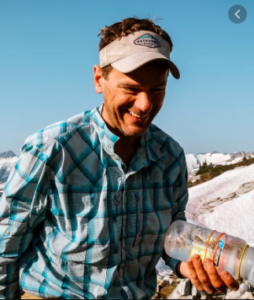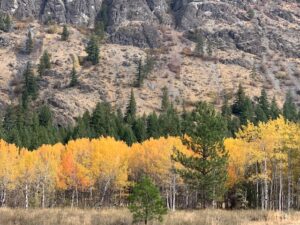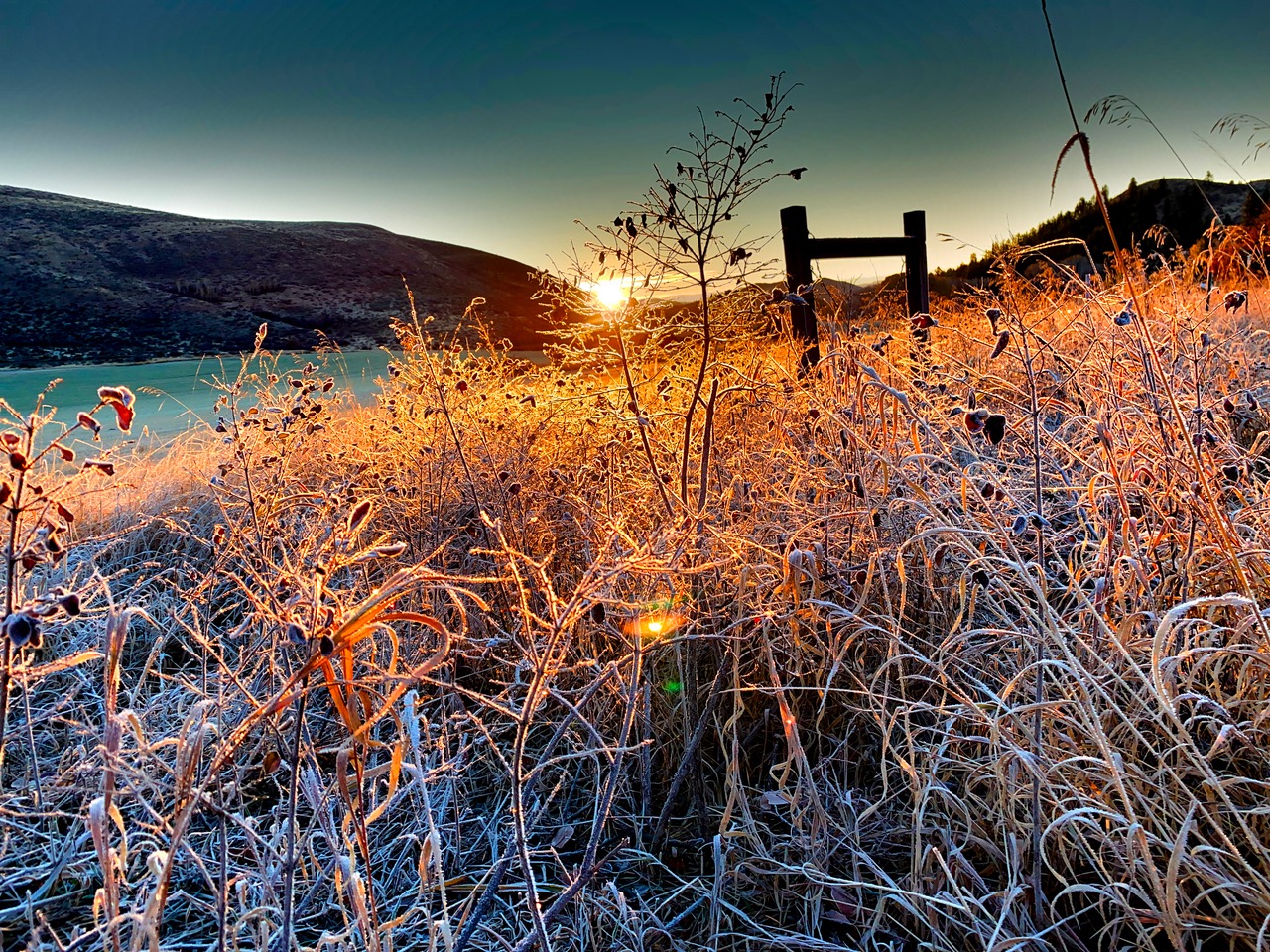Some writing comes together bit by bit, a mosaic of thoughts and observations gathered over days or months or years. Slowly or suddenly, a bigger picture emerges through a confluence of details and facts. Sometimes the writer doesn’t fully grasp what it means until the process of assembling this picture — the act of writing itself — unearths that revelation.
That’s more or less how it was for Chris Solomon when he sat down to write “In My Mountain Town, We’re Preparing for Dark Times,” a personal essay in the New York Times about watching the natural world transition from summer’s crescendo to the haunting depths of winter.

“It was a matter of collecting the observations that we all make as we move through the world,” Solomon said on the phone from his home in the Methow Valley in Washington's North Cascade mountains. “[Then] the process of writing teases out those subtler insights. The act of it reveals what you think.”
Though the essay is written in (very subtle) first person, Solomon turns the camera outward, capturing a portrait of a landscape in seasonal metamorphosis, as deer and aspens, trout and bears — and humans, too — interact in a symphony of change.
Some might call it a “tone poem,” a piece of writing that echoes with sonorous language that evokes a distinct mood. This term also describes a piece of orchestral concert music, a “symphonic poem” intended to tell a story. Both seem fitting to describe what Solomon intended when he sat down to write.
The idea began with an image: deer in the valley, wolfing down food in a way that speaks to the sense of urgency in nature. As the opening of the essay, it introduces a palpable tension, one that, unlike a traditional narrative, doesn’t get resolved.
“I think the larger image I was trying to portray is this sense of frenzy and hunger and dispersal,” Solomon said, “and this idea of calming down and coming back together, and whether that can be done [this year].”
That theme did not emerge until he sat down to write. “That’s one of the things I love about working on an essay,” Solomon said. “It presented itself.”
We took a close look at what makes this essay work and talked to Solomon about his approach. Here are a few key elements:
A sense of place and time
The essay begins with a cinematic scene that anchors the moment in time and place:
At dawn the deer are as thick as cattle in the valley bottom, feeding on what remains after summer’s final haying. Soon, hunting season’s first shot will scatter them to higher country, where winds shake the aspens’ first golden coins to the ground. There’s not much time. So they eat the stubble without pause, fattening up for the hungry months ahead.
Notice the temporal cues, each embedded in visual detail: Dawn. The valley. Summer’s last haying. Hunting season’s first shot. Aspens. Individually, these details are specific and in sharp focus. However, they combine to create an effect that is also impressionistic, imbued with a distinct mood, a sense of wistfulness and urgency: There’s not much time.
Throughout the piece, this theme manifests again and again in different imagery, all of it active and on the concrete end of the ladder of abstraction: ravenous trout striking at flies, a black bear scavenging “the last frost-shriveled berries,” a woodcutter stacking firewood to get through the coldest months.
First-person restraint
While the essay is written in the first person, the author is not the central character. The Methow Valley is. The author is more of a narrator, a supporting character whose presence is most evident in the point of view through which he observes the main character. Kind of like Nick Carraway, the narrator of The Great Gatsby.
“I’m somewhat allergic to the first person in writing,” Solomon said. “The words ‘I’ and ‘me’ can get very cloying very quickly for readers. Nobody finds you as interesting as you find yourself.”
How does one go about writing a first-person essay without overusing I/me/my?
“I try to dip in and out of sections that are very personal,” he says. “I try to keep it about other specifics that speak to the universal. People can read about their own experience filtered through my own.”
On a nuts-and-bolts level, he recommends writing the piece, then doing a round of revision focused on reducing the repetition of I/me/my by rearranging sentences. Often, this shifts the point of view into something resembling the second person, but without use of the word “you.” Readers, relating, become part of the scene.
October’s yellow afternoons smell of winter at the edges.
This autumn feels different than those of the past. The wistfulness of the season is stronger, and the pace of the days feels more urgent.
As author Bronwen Dickey recently put it to me in a text: “More GoPro. Less selfie.”
The universal, told through the particular
Collectively, Solomon’s images combine to portray a singular landscape of mountain country in the Pacific Northwest. But many of them, as vignettes, mirror other places as well, giving readers something to relate to through their own geography.

The “soft ovation of the cottonwoods” could bring to mind New England or Southern California. The “squinting hours around sunrise” and “the return of freezing nights” could happen just about anywhere with warm-and-cold seasons. “October’s yellow afternoons smell of winters at the edges,” as Solomon writes about his mountain town, is true even in Florida, in places without such apparent seasons.
It’s a great example of what I once heard called the “physics of storytelling:” The more intimate and unique the details, the more universal the effect and the emotion. Even if you live in a place without aspens, seeing the wind “shake the aspens’ first golden coins to the ground” stirs up the same feeling as watching the rain bring down the electric-tangerine leaves of a sugar maple.
“You start with a specific and you move toward the universal,” Solomon said.
In this essay, the specific he started with was the deer.
“I hit a deer at the end of the summer, so I’m always thinking about deer as I drive through the valley. I’ve been watching them wolf down food,” Solomon said. “I thought, there are a couple of images that speak to this sense of urgency in nature. Then you take a step back to the universal.”
Thinking about the deer, then stepping back to the universal, that’s when the act of putting thoughts into words teased out one of the most beautiful and meaningful lines in the essay:
It is autumn again in the mountains of the West, and what is not gracefully dying is desperate to live.
Active verbs, necessary adjectives, and simple declarative sentences
Many writing teachers insist that active verbs are more powerful than adjectives. Just look at these muscular verbs:
I tie on an October caddis and skate the fly over the water in the blue morning. Big trout lunge after it, detonating the quiet.
But notice, too, the adjectives, which heighten the specificity of each noun in a necessary way. An October caddis. The blue morning. Big trout. You don’t even have to be much of an angler to know that “big trout” fight and feel and are distinctly different from “trout.”
These muscular verbs and necessary adjectives combine in simple declarative sentences:
And so my friend and I fish too long when we should be picking the last frost-sweetened plums. We put our hands on the still-warm granite of the climbing pitch rather than cook down the applesauce.
With clean and streamlined prose, Solomon evokes the senses. You can taste the unpicked frost-sweetened plums and smell the applesauce that should be simmering even though the actions taken are fishing and scaling that still-warm granite.
“As I’ve gotten older, I realize how much really crisp, plain sentences piled atop one another can be very powerful and beautiful,” Solomon said.
He credits the writing of John McPhee with teaching him the power of writing simply and clearly. “And then, once every several sentences, he smacks you in the face with something that’s just amazing, whether it’s a choice of verb, or a joke, or something that really catches you off guard because the rhythm of the sentences has been so simple and declarative. He chooses his moments carefully to be fancy or ornate.”
The fruits of free writing
Much of the beauty of this essay emerged through Solomon’s practice of free writing, a habit which, through patience and longevity, produces bits of scenes and seeds of ideas that sometimes, but not always, grow into something more.
“I’ll just free write off and on for months, just to get stuff out of me. It’s like vomiting on the page. Seeing what’s interesting, seeing if there are patterns,” Solomon said. “I will free write scraps of sentences, paragraphs — it can be in a notebook, on a computer, on scraps of paper while driving — then collect them. They may amount to nothing. It might take quite a long time to gestate.”
This is particularly useful for personal essays, which may or may not have a clear arc of a narrative.
“I find essays really difficult. I don’t know if I have anything to say or not. Half the time it amounts to nothing and it stays in a notebook, sometimes for years. But sometimes I have something that’s sort of interesting as I sit down and work on it. That’s the most satisfying part about being a writer. Realizing maybe you know more than you think you do. I find that extremely satisfying.”
Kim Cross a full-time freelance writer and author of "What Stands in a Storm," a New York Times best-selling account of the biggest tornado outbreak on record.



